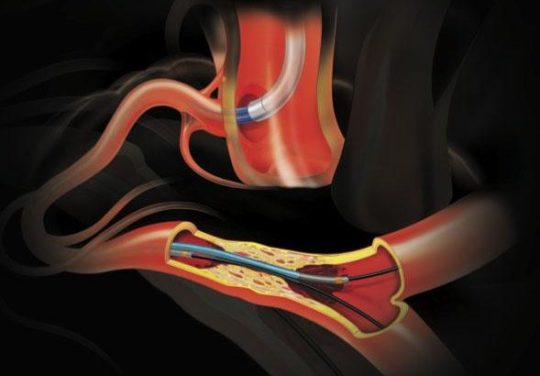#progreate
Photo

Portrait of Grace Lee Boggs - for AAPI event @ Indeed
#AAPI#grace lee boggs#Artwork#illustration#digital illustration#adobe illustrator#social justice#sociallyconscious#american author#Social activist#feminist#philosopher#portraiture#digital portrait#asian american#asian american history#digital painting#progreate
5 notes
·
View notes
Text
Transcatheter arterial Embolization of the common hepatic artery for pseudoaneurysm after a laparoscopic-assisted pancreaticoduodenectomy: A case report by Yongxiang Li in Journal of Clinical Case Reports Medical Images and Health Sciences

INTRODUCTION
Pancreaticoduodenectomy (PD) is the main procedure for some surgeries related to the pancreas. Due to the advance of the surgical technology in recent two decades, mortality decreased considerably [1]. However, the morbidity rate for the major complication after PD remains high [2]. In the various complications, postpancreatectomy hemorrhage (PPH) is a fatal complication, which is linked with 11%−38% of the overall mortalities [3−6]. According to the International Study Group of Pancreatic Surgery [7], late PPH is caused by a ruptured pseudoaneurysm. Once the pseudoaneurysm ruptures, laparotomy and endovascular intervention are the main treatment to be done.
Here we report the clinical features, diagnosis, and treatment of a case of massive hemorrhage in the common hepatic artery (CHA) for pseudoaneurysm after PD.
CASE REPORT
A 48-year-old male patient underwent a modified Child PD for the malignant tumor of the descending duodenum. The gastroscope and abdominal enhanced computed tomography (CT) in the preoperative examinations are displayed in Fig. 1. The related index and laboratory values of the patients showed no abnormal outcomes. Standard modified Child PD was performed after excluding the surgical contraindications. No adverse events occurred during the operation. Antibiotic prophylaxis was administered in the postoperative treatment. On postoperative day (POD) 2, the patient suffered from fever and abdominal pain. Persistent peritoneal lavage and drainage were conducted to prevent anastomotic leakage. On POD 8, the continuous drainage stopped because of disappearing abdominal pain. On POD 10, the patient had a sudden abdominal pain and showed 50 mL loss of blood from the drain of cholangiojejunostomy. Hemoglobin concentration decreased to 85 g/L, which had dropped by 45 g/L compared to the last inspection. At the same time, the amylase level measured in the intra-abdominal drainage fluid was 1480u/L. In terms of diagnosis, pancreatic fistula and intra-abdominal bleeding were considered. Conservative treatment, including fluid infusion, use of hemostatic agents, and blood transfusion, was used for this patient. Then, the patient’s condition was stabilized gradually. Abdominal CT was performed on the POD 19, which revealed the existence of bloody fluid collection around the perihepatic area (Fig. 2). On POD 21, the patient underwent catheter drainage under the guidance of ultrasonic from the perihepatic area. Abdominal distension of the patients improved. However, on POD 25, the patient abruptly developed melena and hematemesis, and vomited about 300 mL of bloody fluid. A total of 200 mL bright red bloody fluid drained from the abdominal tube. Then, the patient suffered from a shock with hypotension and tachycardia. Hence, Active abdominal bleeding was considered. Urgent Digital Subtraction Angiography (DSA) performed on the basis of a joint decision between the interventional radiologist and a surgeon. DSA revealed a pseudoaneurysm after the rupture of the CHA (Fig. 3a, Video 1). Then, embolization of the hepatic artery with microcoil was performed successfully (Fig. 3b, Video 2). The patient’s blood pressure returned to normal after embolization. And then the patient regained hemodynamic stability and was transferred to the Intensive Care Unit (ICU). The patient was successfully discharged from the hospital on POD 38. There were no obvious abnormalities in the patient’s reexamination after three months.
DSA procedure:
The patient lied supine on the DSA table; a puncture in the right femoral artery was performed after local anesthesia. The 5FRH catheter was placed into the right femoral artery, the catheter head was inserted into the celiac trunk artery for DSA, and the super-selected microcatheter (Terumo Progreat microcatheter, Japan) was inserted into the hepatic artery. After the hepatic artery, its branches were identified by contrast; the embolization microcoil was placed, followed by the injection of the histoacryl (B.Braun Closure Specialities, Germany) into the hepatic artery. Ultimately, the hepatic artery and its branches did not develop again and hence were not visualized under DSA.
DISCUSSION
Commonly, complications develop after PD; there is no doubt that PPH is dangerous and fatal. Furthermore, a ruptured pseudoaneurysm is the most severe and fatal cause of PPH [8]. The formation of the pseudoaneurysm is associated with the damage to the vascular wall. Although adequate lymph node dissection and skeletonization of the vessels in surgery may significantly improve the patient’s prognosis, the dissection and skeletonization make the arterial wall weak and vulnerable, which is susceptible to erosion by trypsin and elastase from the digestive juice [9].
Then, we analyzed the pathogenesis of this case, which may be related to laparoscopic instrument operation. Especially, the dissociation of vessels and dissection of the lymph nodes caused excessive skeletonization, and then the Hem-o-lock ligation damaged the arterial wall, which may lead to the formation of the pseudoaneurysm in the stump of the ligated artery.
In this case, intraperitoneal hemorrhage occurred after surgery, and the measured drainage liquid amylase was 1480u/L; thus, it was considered that the digestive fluid leak caused by the pancreatic fistula, corroded the blood vessels and eventually led to bleeding. After conservative treatment, there is a possibility of hemodynamic instability that would require emergency DSA examination; the formation of a pseudoaneurysm of the CHA and arterial embolism are also considered. Microcoil was chosen given the hemodynamic instability of the patients; while the liver has a double blood supply, a simple embolism is not likely to cause liver ischemia necrosis. Microcoil and histoacryl embolization were chosen given.
A recent meta-analysis revealed that endovascular treatment of a ruptured pseudoaneurysm had low mortality and morbidity and high success rate than surgical intervention [10,11]. endovascular treatment is considered the first choice in the treatment of pseudoaneurysm recently. Endovascular treatment consists of Transcatheter Arterial Embolization (TAE) and stent-graft placement. Coil embolization as a TAE is an effective approach for the treatment of a pseudoaneurysm [12,13].
In this case, we summarized several experiences for the iatrogenic traumatic pseudoaneurysm. First, excessive skeletonization of the blood vessels should be avoided, which leads to the injury of the endangium. In addition, when dealing with the stump of the gastroduodenal artery, the lymph node should be proper to avert excessive skeletonization. Second, compression, avulsion, clamping, or stretching of the skeletonization vessels in the laparoscopic operation increases the risk of bleeding and may cause injury of the endangium. Therefore, accurate vascular localization is the key to a successful operation, and improper operation should be avoided especially when ligating the arteries. Third, when using the Hem-o-lock to ligate the artery, it should be closed slowly, which avoids the shearing action to vessels in the closure process, and damage to the arterial stump. Finally, the vessels and lymph nodes should be skeletonized with laparoscopic instruments by blunt dissection. According to our experience, the skeletonization of the blood vessels tends to be covered with an omental flap to prevent hemorrhage after the PD. Several studies [14,15] revealed that the omental flap or falciform ligament placement over a skeletonization of blood vessels could be an effective measure for the prevention of pseudoaneurysm formation after PD.
In conclusion, this case demonstrated the successful experience for the treatment of delayed PPH by TAE. Endovascular treatment is the first choice for the diagnosis and treatment of a ruptured pseudoaneurysm after PD. Although a stent-graft placement is considered a first-line treatment in the endovascular treatment, coil embolization is a reliable, safe, and effective method particularly when unstable hemodynamics of the patient was observed. In a word, when making the treatment plan, the patient’s condition, presentation, and clinical history should be taken into consideration.
Statements for written informed consent
The author has obtained the patient's handwritten informed consent (pic1, 2).
Acknowledgement
Thanks to Xin Xu, Youliang Wu for guiding the format modification and submission of the magazine.
Conflict of Interest Statement
The authors declare no conflict of interest.
Consent for publication
All authors agree to publish the paper.
Funding Sources
This work was supported by a grant from the National Natural Science Foundation of China (81874063) and Natural Science Foundation of Anhui Province (2008085QH408).
Authors’ Contributions
Lifeng Xu collect all the article data and is responsible for writing the full text. Bo Yang participated in the writing of the article and the modification of the article format. Yongxiang Li provided the ideas for the research and all the funding. All authors read and approved the final manuscript.
Availability of data and materials
The datasets used or analysed during the current study are available from the corresponding author on reasonable request.
For more information: https://jmedcasereportsimages.org/about-us/
For more submission : https://jmedcasereportsimages.org/
#Pancreaticoduodenectomy#mortality#Embolization#hepatic#diagnosis#PPH#anesthesia#Yongxiang Li#jcrmhs
0 notes
Text
As well as providing treatment, micro guide catheters can be of great assistance to others in many different fields as well
As well as providing treatment, micro guide catheters can be of great assistance to others in many different fields as well
In the realm of catheter technology, micro guide catheters are a well-known kind of catheter. They have several characteristics that distinguish them from other types of catheters. Micro Catheters is a fast-growing market area. This market segment is growing in lockstep with the health care technology market. These catheters are designed in such a way that they avoid skin breakdown and other…

View On WordPress
0 notes
Text

The Magical, the Marvelous, Mister Mistoffelees!
Watch me paint in progreate for the first time:
#character design#character art#my art#cats the musical#drawing#fanart#cats 1998#cats fanart#cats as animation#oggysart#catart#musical fanart#illustration#digital painting#furry art
309 notes
·
View notes
Video
youtube
PGD - LOTO (Petite Gourmandise Dessinée)
0 notes
Text
Microcatheter Market Research for 2017 Examined in New Report
Microcatheter Market Research for 2017 Examined in New Report
Summary Micro-catheters are commonly found throughout the medical device and healthcare industries. With companies trying to develop and market products that meet the demanding needs of physicians and healthcare providers around the world Market Segment as follows: Download Sample Pages of Given Report…
View On WordPress
#Microcatheter#microcatheter components#Microcatheter Market forecast#Microcatheter Market price#Microcatheter Market trends#Microcatheter price#microcatheter progreat#Microcatheter size#microcatheter system#microcatheter terumo#Microcatheter usses
0 notes